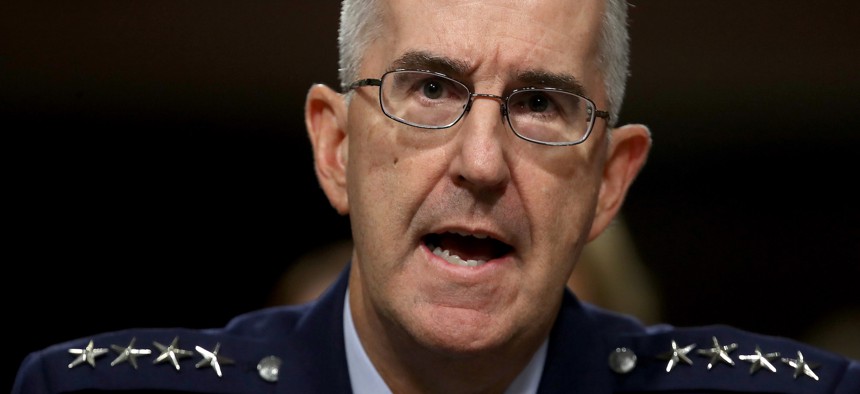
U.S. Air Force Gen. John E. Hyten testifies before the Senate Armed Services Committee in 2019. Win McNamee/Getty Images
Hyten: US Must Broaden Its Strategic Deterrence Concept — and Keep Its ICBMs
The Joint Chiefs vice chair said a “new strategic defense review” should take account of communications and sensors.
How do you deter an adversary armed with nuclear weapons? Gen. John Hyten, the Vice Chairman of the Joint Chiefs of Staff, says the United States should rethink the fundamental “structure” of nuclear deterrence that has remained largely unchanged since Herman Kahn and others grappled with with with it in the 1950s and 1960s. But, he added: don’t discard ground-based intercontinental nuclear missiles, as many in the arms control community have been urging the Biden administration to do.
The U.S. needs to re-examine and possibly broaden what it means by “strategic” and conduct a "strategic deterrence review," Hyten said this week at separate events hosted by the Center for Strategic and International Studies, or CSIS, and the Air Force Association. The term is historically used to refer to nuclear weapons delivered by ICBMs, sub-launched missiles, and nuclear bombers. But deterring such an attack takes more than offensive weapons; it also relies on vulnerable networks of sensors and communications gear. Hyten said any attack on those should be considered “strategic.”
“Any strategic attack — we can look at an opportunity to respond through any number of domains” — meaning land, air, sea, space, and cyberspace — “that we want to. So when you look across the board at strategic deterrence, you have to look across the board in those broad terms,” he said at the Air Force Association event.
The comments are similar to those made by his predecessor and they echo the 2018 Nuclear Posture Review, which says that the United States must ensure that adversaries understand that there are no “possible benefits from non-nuclear aggression or limited nuclear escalation. Correcting any such misperceptions is now critical to maintaining strategic stability in Europe and Asia.”
But in his Air Force Association remarks, posted on Friday, Hyten went a bit further. He argued that the United States needs a broader review of strategic deterrence. He said ”I think as we look through the next couple of years of a new administration I would like to see all of those things together in a strategic deterrence review. Because when you look through offense, defense, and all those capabilities together it's really about strategic deterrence. It’s not just about nuclear posture…not about missile defense, not just about space…it’s about all those things together that provide our overall strategic capability and our ability to strategically deter our adversaries,”
Hyten said this is “going to be a difficult problem because we’ve not fully thought it through. But the one thing I know is that without the backstop of the nuclear triad...it starts falling apart from the very beginning.”
Take that as a less-than-subtle endorsement for the plan to replace of U.S.ground-based nuclear missiles. Some have urged U.S. leaders to abandon that leg of the triad, in part, because the missiles’ location is always known to the other side, as opposed to bombers and submarines. Also, because of the amount of time it takes them to reach their targets after launch, they give the president the least amount of time to make a humanity-ending decision. Others have urged the Biden administration to at least re-think modernizing them, which the Congressional Budget Office has calculated to cost $61 billion over ten years.
Hyten put forward a defense of ICBMs on Friday, calling them the leg of the triad that is “the most difficult to fully target because in order to target 400 silos across five states in the middle of America an adversary has to commit hundreds, if not thousands, of nuclear weapons in order to try to take that leg out. And if you do that no STRATCOM commander has any problem telling the president of the United States what you have to do.” He called the decision to launch a coordinated, full-scale ICBM attack against the United States “almost an impossible decision to make” for any adversary.
But those adversarial calculations would change if the United States were to remove that leg of the triad, which, Hyten argued, would diminish U.S. offensive capability considerably. “You’re down to a number of platforms you could take out with 20 strategic weapons that could be nuclear and non-nuclear to get after the entire thing because of the way we have the alert posture on the bomber force, the way we have our submarines deployed.”
That would bring the United States “basically an intelligence failure or a technical failure away from losing the entire structure.”
Hyten cautioned that such a move would radically change the balance of nuclear deterrence since the United States and Russia together possess far more nuclear weapons than does China. “If you go to that kind of number, all of a sudden China becomes a peer adversary and maybe even a superior adversary in their nuclear capability and we don’t understand their nuclear doctrine and that puts you in a difficult place. So with that ground-based leg that overall deterrence, especially with China, is really challenged.”
Kingston Reif, the director for disarmament and threat reduction policy at the Arms Control Association, took issue with Hyten’s logic. “Why would Russia risk attacking the U.S. homeland with nuclear weapons when at least 700 U.S. warheads would remain at sea to respond — to say nothing about any remaining bomber forces? Gen. Hyten alludes to the potential unforeseen emergence of a vulnerability to the submarine force. But in that case, silo-based ICBMs would not provide a reliable hedge given their vulnerability.”
Said Reif, whatever benefits ICBMs have, “They can be had at lower numbers and by deferring the development of a new ICBM. Life-extended Minuteman III missiles can get blown up in their silos by incoming Russian ICBMs less expensively than new GBSD missiles."




